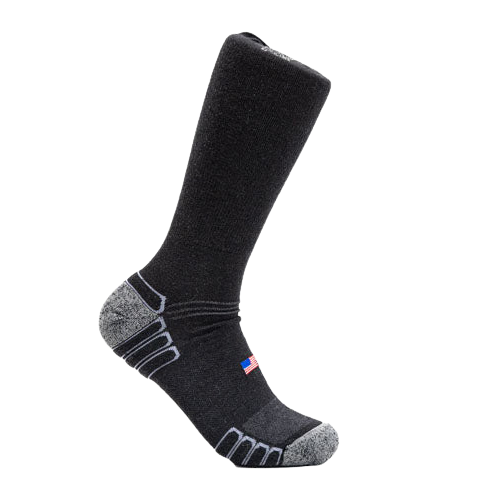Thanks to its durability, resilience against punctures, and natural electrical resistance, leather is ideal for building work boots.
There’s really just one problem: leather gets very easily damaged when exposed to water.
Water weakens the leather fibers, causing them to sag, stretch, fade, and even rot.
Over time, even the finest leather boots will deteriorate with repeated exposure to moisture.
Unless the boots are waterproof, that is.
Modern waterproofing methods make it brilliantly easy to protect your work boots against exposure to dampness in all forms—be it mud, snow, sleet, slush, rain, or dew.
With just a few bucks and a few minutes of work, you can extend the lifespan of your work boots by anywhere from six months to six years.
Most Common Treatments for Waterproofing Work Boots

There are plenty of DIY solutions available to waterproof your work boots, including:
Waterproof Waxes
Boot wax is typically made from either beeswax, lanolin (oil extracted from sheep’s wool), or a combination of both. When applied and allowed to absorb properly, it can be a highly efficient waterproofing method—which is why humans have been using wax in waterproof and water-resistant materials like waxed canvas, sailcloth, and boot leather for centuries.
What you'll need:
- Waterproofing treatment of choice (in this case, we’re using pure beeswax)
- Boot brush (for dry brushing)
- Toothbrush
- Soft cloth
- Heat gun (or hairdryer)
Step 1: Strip Boot Down and Remove Laces
Start by removing the laces—and, if the boot has one, the false tongue. Stripping the boot down makes it easy to really seal up all the nooks, crannies, and seams that water might seep through.
Step 2: Dry Brush (or Clean With a Wet Cloth if Excessively Dirty)
If your boots are reasonably clean (not crusted with mud, dirty, or stained), you can simply use a dry, stiff-bristle brush to scrub them down.
The goal is to brush off all the dirt, mud, dust, sand, and anything else that might be caught in the seams or between the threads. Pay extra attention to any joints or seams, folds in the leather, and all the little hidden spots between the boot's upper and tongue.
Step 3: Use a Toothbrush to Clean the Seams
To really maximize the effectiveness of the wax application, you need to make sure the boot is as clean as possible. Any little bits of sand, mud, dust, dirt, or other particulates will get trapped in the seams by the wax layer and speed up the deterioration of the threads and leather.
Once you’re done brushing off the bulk of the boot’s upper, take a toothbrush to every seam and joint in the boot to make sure it’s as clean as possible. A few minutes of extra work can make a big difference in your boots’ longevity.
Step 4: Polish Before You Wax

Give the boot one last little polishing wipe with a soft microfiber cloth as the final step in the cleaning process. This will get off any remaining dirt or dust particles and leave your boots as clean as possible—and ready to be waxed.
Step 5: Heat the Boot (and Wax) With Head Gun
The heat gun will serve two purposes in waterproofing your work boots:
- Heating up the leather so the fibers relax and open up to absorb the beeswax more efficiently.
- Softening/melting the beeswax so it applies more evenly across the boot.
Turn on the heat gun and hold it 2-4 inches from the leather boot. The exact optimal distance will vary from boot to boot, based on the leather.
It’s always better to err on the side of less heat, as too much will damage the leather, and too little will only make the process a bit slower.
Heat the leather around the toe first, and use the heat gun to heat up the beeswax, too. Rub the wax directly onto the leather.
Keep rubbing until you see the “wax bloom”—a.k.a. wax forming on the boot's surface. This will tell you the leather has absorbed as much wax as it possibly can. Once you see this, move on to another spot.
Step 6: Work the Wax Into the Leather, Heating As You Go
Use the heat gun to keep softening the leather and melting the wax as you apply it. Once the wax forms and dries on the surface of the leather, apply a little more heat to help it absorb more efficiently into the boot.
Move up the side of the boot, working your way toward the upper and shaft. Work all the way around the back of the boots, then up the other side.
Finish off with the tongue and the seams around the lacing eyeholes.
Try to apply an even, thorough layer across the entire boot. Take your time on each section of the boot, really rubbing the melted wax (gently but evenly) into the heated leather.
Step 7: Examine the First Coat
After you finish the first application, give the boots a minute or two to cool fully and for the wax to absorb into the leather and harden.
Take a look at your handiwork. Did you miss any spots, particularly around the seams?
You’ll often find the cracks between the boots’ leather upper and outsoles are easy to miss. You might need to melt the beeswax directly using the heat gun and allow it to drip into the seams.
Step 8: Apply Additional Coats as Needed, Working Into All Areas of the Boot
One coat of wax will typically be adequate for waterproofing, provided it’s applied evenly.
However, multiple coats of wax will add a really lovely gloss and shine to your work boots. More wax can also help repair some of the damage (scuffs, scratches, dings, etc.) sustained during work use.
Step 9: Allow Wax to Absorb and Boots to Dry Completely
Once you’re satisfied with your wax application, let the boots dry completely so the leather absorbs the wax fully.
You’ll notice that after you apply the wax, the leather will get a bit harder and stiffer. You won’t lose so much of the leather’s natural suppleness that the boots will become uncomfortable, though. It’s just a minor degree of stiffness that will relax once you wear the boots and the wax warms up.
Waterproofing Sprays
Waterproofing sprays are typically silicone-based treatments. The tiny silicone particles in the spray adhere to the boot leather, providing an exterior coating that shrugs off water and damp but still allows the material to breathe.
These sprays are a more synthetic and “high-tech” approach to waterproofing your work boots.
Oils
Oil-based waterproofing treatments are as tried-and-true as wax treatments. The more typical oils you’ll find are neatsfoot oil, mineral oil, and mink oil.
The oils penetrate into the leather (rather than just being applied to the surface), and they can both waterproof and condition the leather.
Oils are less effective at waterproofing than waxes and sprays, however. You also can’t apply too much oil (in an effort to increase waterproofing) or else risk damaging your boots.
Pastes and Creams
Waterproofing pastes and creams are simply different formulations of the same thing: treatments that use oil, wax, or a combination of both to protect your boots from moisture.
Creams are often made using lanolin, while pastes may use more beeswax.
Whatever the ingredient, the use remains the same, and the effects are fairly similar. The creams and pastes will apply a somewhat waterproof layer while gently conditioning and softening the boot leather.
Seam Sealants
Seam sealants are typically urethane-based and are best applied directly to the boot seams, which are the parts most likely to leak.
By sealing the seams (before you apply your general waterproofing wax, paste, oil, cream, or spray), you double up on the protection.
Conclusion

That’s really all it is!
If you’ve taken your time cleaning, wiping, and waxing the boots, you’ll have invested around 20 minutes of your day. But doing this once a year is all you really need to add that extra layer for waterproofing and protection against damage.
Waxing won’t replace regular care and maintenance. You’ll still need to regularly clean and condition your boots—I recommend every 2-3 months for work boots.
But the application of beeswax will do wonders to protect the leather from moisture and slow down its natural deterioration.
A good pair of work boots is already built to last anywhere from three to ten years on the job. Adding a layer of protective wax can extend the lifespan of the leather significantly, so they last a whole lot longer.






